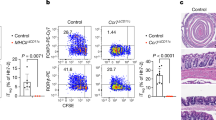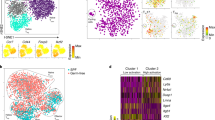Abstract
Commensal microbiota shapes the intestinal immune system by regulating T helper (TH) cell lineage differentiation. For example, Bacteroides fragilis colonization not only optimizes the systemic TH1/TH2 balance, but also can induce regulatory T (Treg) cell differentiation in the gut. In addition, segmented filamentous bacteria (SFB) facilitate the development of TH17 cells in the small intestine. The 17 strains within clusters IV, XIVa, and XVIII of Clostridiales found in human feces can also induce the differentiation and expansion of Treg cells in the colon. Thus, the regulation of TH cell differentiation by commensal bacteria is evident; however, the molecular mechanisms underlying these processes remain uncertain. Recent studies have demonstrated that bacterial components, as well as their metabolites, play a central role in regulating TH cell development. Furthermore, these metabolites can elicit changes in histone posttranslational modification to modify the expression of critical regulators of T cell fate. In this review, we discuss the mechanisms and biological significance of microbiota-dependent TH differentiation.




Similar content being viewed by others
References
Nicholson JK, Holmes E, Kinross J et al (2012) Host-gut microbiota metabolic interactions. Science 336:1262–1267
Sommer F, Bäckhed F (2013) The gut microbiota—masters of host development and physiology. Nat Rev Microbiol 11:227–238
Tomboli CP, Neut C, Desreumaux P, Colombel JF (2003) Dysbiosis in inflammatory bowel disease. Gut 53:1–4
Ivanov II, Atarashi K, Manel N et al (2009) Induction of intestinal Th17 cells by segmented filamentous bacteria. Cell 139:485–498
Geuking MB, Cahenzli J, Lawson MAE et al (2011) Intestinal bacterial colonization induces mutualistic regulatory T cell responses. Immunity 34:794–806
Atarashi K, Tanoue T, Shima T et al (2011) Induction of colonic regulatory T cells by indigenous Clostridium species. Science 331:337–341
Brestoff JR, Artis D (2013) Commensal bacteria at the interface of host metabolism and the immune system. Nat Immunol 14:676–684
Mazmanian SK, Liu CH, Tzianabos AO, Kasper DL (2005) An immunomodulatory molecule of symbiotic bacteria directs maturation of the host immune system. Cell 122:107–118
Cahenzli J, Köller Y, Wyss M et al (2013) Intestinal microbial diversity during early-life colonization shapes long-term IgE levels. Cell Host Microbe 14:559–570
Koloski NA (2008) Hygiene hypothesis in inflammatory bowel disease: a critical review of the literature. World J Gastroenterol 14:165–173
Umetsu DT, McIntire JJ, Akbari O et al (2002) Asthma: an epidemic of dysregulated immunity. Nat Immunol 3:715–720
Mazmanian SK, Round JL, Kasper DL (2008) A microbial symbiosis factor prevents intestinal inflammatory disease. Nature 453:620–625
Atarashi K, Honda K (2011) Microbiota in autoimmunity and tolerance. Curr Opin Immunol 23:761–768
Tanoue T, Honda K (2012) Induction of Treg cells in the mouse colonic mucosa: a central mechanism to maintain host-microbiota homeostasis. Semin Immunol 24:50–57
Duan J, Kasper DL (2011) Regulation of T cells by gut commensal microbiota. Curr Opin Rheumatol 23:372–376
Wang Q, McLoughlin RM, Cobb BA et al (2006) A bacterial carbohydrate links innate and adaptive responses through Toll-like receptor 2. J Exp Med 203:2853–2863
Imanishi T, Hara H, Suzuki S et al (2007) Cutting edge: TLR2 directly triggers Th1 effector functions. J Immunol 178:6715–6719
Atarashi K, Nishimura J, Shima T et al (2008) ATP drives lamina propria TH17 cell differentiation. Nature 455:808–812
Goto Y, Panea C, Nakato G et al (2014) Segmented filamentous bacteria antigens presented by intestinal dendritic cells drive mucosal Th17 cell differentiation. Immunity 40:594–607
Chaudhry A, Samstein RM, Treuting P et al (2011) Interleukin-10 signaling in regulatory T cells is required for suppression of Th17 cell-mediated inflammation. Immunity 34:566–578
Walker LSK, Sansom DM (2011) The emerging role of CTLA4 as a cell-extrinsic regulator of T cell responses. Nat Rev Immunol 11:852–863
Riella LV, Paterson AM, Sharpe AH, Chandraker A (2012) Role of the PD-1 pathway in the immune response. Am J Transplant 12:2575–2587
Abbas AK, Benoist C, Bluestone JA et al (2013) Regulatory T cells: recommendation to simplify the nomenclature. Nat Immunol 14:307–308
Thornton AM, Korty PE, Tran DQ et al (2010) Expression of Helios, an Ikaros transcription factor family member, differentiates thymic-derived from peripherally induced Foxp3+ T regulatory cells. J Immunol 184:3433–3441
Yadav M, Louvet C, Davini D et al (2012) Neuropilin-1 distinguishes natural and inducible regulatory T cells among regulatory T cell subsets in vivo. J Exp Med 209:1713–1722
Weiss JM, Bilate AM, Gobert M et al (2012) Neuropilin 1 is expressed on thymus-derived natural regulatory T cells, but not mucosa-generated induced Foxp3+ T reg cells. J Exp Med 209:1732–1742
Obata Y, Furusawa Y, Endo TA et al (2014) The epigenetic regulator Uhrf1 facilitates the proliferation and maturation of colonic regulatory T cells. Nat Immunol 15:571–579
Round JL, Mazmanian SK (2010) Inducible Foxp3+ regulatory T-cell development by a commensal bacterium of the intestinal microbiota. Proc Natl Acad Sci 107:12204–12209
Frank DN, St Amand AL, Feldman RA et al (2007) Molecular-phylogenetic characterization of microbial community imbalances in human inflammatory bowel diseases. Proc Natl Acad Sci 104:13780–13785
Sokol H, Seksik P, Furet JP et al (2009) Low counts of Faecalibacterium prausnitzii in colitis microbiota. Inflamm Bowel Dis 15:1183–1189
Atarashi K, Tanoue T, Oshima K et al (2013) Induction by a rationally selected mixture of Clostridia strains from the human microbiota. Nature 500:232–236
Smith PM, Howitt MR, Panikov N et al (2013) The microbial metabolites, short-chain fatty acids, regulate colonic Treg cell homeostasis. Science 341:569–573
Arpaia N, Campbell C, Fan X et al (2013) Metabolites produced by commensal bacteria promote peripheral regulatory T-cell generation. Nature 504:451–455
Furusawa Y, Obata Y, Fukuda S et al (2013) Commensal microbe-derived butyrate induces the differentiation of colonic regulatory T cells. Nature 504:446–450
Singh N, Gurav A, Sivaprakasam S et al (2014) Activation of Gpr109a, receptor for niacin and the commensal metabolite butyrate, suppresses colonic inflammation and carcinogenesis. Immunity 40:128–139
Pryde SE, Duncan SH, Hold GL et al (2002) The microbiology of butyrate formation in the human colon. FEMS Microbiol Lett 217:133–139
Narushima S, Sugiura Y, Oshima K et al (2014) Characterization of the 17 strains of regulatory T cell-inducing human-derived Clostridia. Gut Microbe 5:333–339
Annison G, Illman RJ, Topping DL (2003) Acetylated, propionylated or butyrylated starches raise large bowel short-chain fatty acids preferentially when fed to rats. J Nutr 133:3523–3528
Kim SV, Xiang WV, Kwak C et al (2013) GPR15-mediated homing controls immune homeostasis in the large intestine mucosa. Science 340:1456–1459
Trompette AEL, Gollwitzer ES, Yadava K et al (2014) Gut microbiota metabolism of dietary fiber influences allergic airway disease and hematopoiesis. Nat Med 20:159–166
Cedar H, Bergman Y (2009) Linking DNA methylation and histone modification: patterns and paradigms. Nat Rev Genet 10:295–304
Kornberg RD, Lorch Y (1992) Chromatin structure and transcription. Ann Rev Cell Biol 8:563–587
Jenuwein T (2001) Translating the histone code. Science 293:1074–1080
Zhang Y (2003) Transcriptional regulation by histone ubiquitination and deubiquitination. Gene Dev 17:2733–2740
Lee DY, Hayes JJ, Pruss D, Wolffe AP (1993) A positive role for histone acetylation in transcription factor access to nucleosomal DNA. Cell 72:73–84
Weng N-P, Araki Y, Subedi K (2012) The molecular basis of the memory T cell response: differential gene expression and its epigenetic regulation. Nat Rev Immunol 12:306–315
Zediak VP, Wherry EJ, Berger SL (2011) The contribution of epigenetic memory to immunologic memory. Curr Opin Gene Dev 21:154–159
Turner SJ (2013) T cell immunity as a tool for studying epigenetic regulation of cellular differentiation. Front Genet 4(218):1–10
Afzali B (2013) Thymic versus induced regulatory T cells—who regulates the regulators? Front Immunol 4(169):1–22
Zheng Y, Josefowicz S, Chaudhry A et al (2010) Role of conserved non-coding DNA elements in the Foxp3 gene in regulatory T-cell fate. Nature 463:808–812
Candido EP, Reeves R, Davie JR (1978) Sodium butyrate inhibits histone deacetylation in cultured cells. Cell 14:105–113
Licciardi PV, Wong S-S, Tang ML, Karagiannis TC (2010) Epigenome targeting by probiotic metabolites. Gut Pathog 2:24
Vinolo MA, Rodrigues HG, Nachbar RT et al (2011) Regulation of inflammation by short chain fatty acids. Nutrient 3:858–876
Chang PV, Hao L, Offermanns S et al (2014) The microbial metabolite butyrate regulates intestinal macrophage function via histone deacetylase inhibition. Proc Natl Acad Sci 111:2247–2252
Witt O, Deubzer HE, Milde T, Oehme I (2009) HDAC family: what are the cancer relevant targets? Cancer Lett 277:8–21
Davie JR (2003) Inhibition of histone deacetylase activity by butyrate. J Nutr 133:2485S–2493S
Beier UH, Wang L, Han R et al (2012) Histone deacetylases 6 and 9 and sirtuin-1 control Foxp3+ regulatory T cell function through shared and isoform-specific mechanisms. Sci Signal 5:ra45
Tao R, de Zoeten EF, Ozkaynak E et al (2007) Deacetylase inhibition promotes the generation and function of regulatory T cells. Nat Med 13:1299–1307
Burchill MA, Yang J, Vogtenhuber C et al (2006) IL-2 receptor-dependent STAT5 activation is required for the development of Foxp3+ regulatory T cells. J Immunol 178:280–290
van Loosdregt J, Vercoulen Y, Guichelaar T et al (2010) Regulation of Treg functionality by acetylation-mediated Foxp3 protein stabilization. Blood 115:965–974
Kim HP, Leonard WJ (2007) CREB/ATF-dependent T cell receptor-induced FoxP3 gene expression: a role for DNA methylation. J Exp Med 204:1543–1551
Huehn J, Polansky JK, Hamann A (2009) Epigenetic control of FOXP3 expression: the key to a stable regulatory T-cell lineage? Nat Rev Immunol 9:83–89
Portela A, Esteller M (2010) Epigenetic modifications and human disease. Nat Rev Biotechnol 28:1057–1068
Josefowicz SZ, Wilson CB, Rudensky AY (2009) Cutting edge: TCR stimulation is sufficient for induction of Foxp3 expression in the absence of DNA methyltransferase 1. J Immunol 182:6648–6652
Lal G, Zhang N, van der Touw W et al (2009) Epigenetic regulation of Foxp3 expression in regulatory T cells by DNA methylation. J Immunol 182:259–273
Sharif J, Muto M, Takebayashi S-I et al (2007) The SRA protein Np95 mediates epigenetic inheritance by recruiting Dnmt1 to methylated DNA. Nature 450:908–912
Bertoli C, Skotheim JM, de Bruin RAM (2013) Control of cell cycle transcription during G1 and S phases. Nat Rev Mol Cell Biol 14:518–528
Yang W, Bancroft L, Augenlicht LH (2005) Methylation in the p21WAF1/cip1 promoter of Apc+/−, p21+/− mice and lack of response to sulindac. Oncogene 24:2104–2109
Kim JK, Esteve PO, Jacobsen SE, Pradhan S (2008) UHRF1 binds G9a and participates in p21 transcriptional regulation in mammalian cells. Nucl Acid Res 37:493–505
Koinuma D, Tsutsumi S, Kamimura N et al (2008) Chromatin immunoprecipitation on microarray analysis of Smad2/3 binding sites reveals roles of ETS1 and TFAP2A in transforming growth factor signaling. Mol Cell Biol 29:172–186
Fontenot JD, Rasmussen JP, Gavin MA, Rudensky AY (2005) A function for interleukin 2 in Foxp3-expressing regulatory T cells. Nat Immunol 6:1142–1151
Yang X-P, Ghoreschi K, Steward-Tharp SM et al (2011) Opposing regulation of the locus encoding IL-17 through direct, reciprocal actions of STAT3 and STAT5. Nat Immunol 12:247–254
Acknowledgments
This work was supported in part with grants from the Japan Society for the Promotion of Science (24117723 to K.H. and 24890293 to Y.F.), the Japan Science and Technology Agency (K.H.), and the Ministry of Health Labour and Welfare (K.H.).
Conflict of interest
The authors have no conflict of interest to disclose.
Author information
Authors and Affiliations
Corresponding author
Additional information
This article is a contribution to the Special Issue on Microbiome, Immunity and Inflammation - Guest Editor: Hiroshi Ohno
Rights and permissions
About this article
Cite this article
Furusawa, Y., Obata, Y. & Hase, K. Commensal microbiota regulates T cell fate decision in the gut. Semin Immunopathol 37, 17–25 (2015). https://doi.org/10.1007/s00281-014-0455-3
Received:
Accepted:
Published:
Issue Date:
DOI: https://doi.org/10.1007/s00281-014-0455-3




